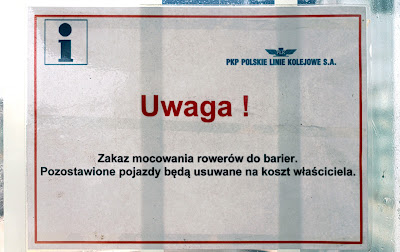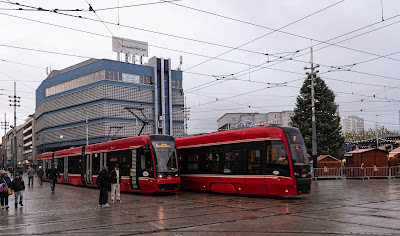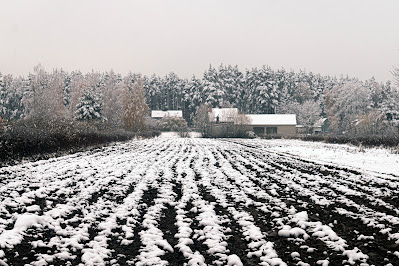Rather than hang around after the post-conference speakers' lunch to wait for the night train from Szczecin to Warsaw (departing at 22:38), I decide (once again) to travel out to Świnoujście and catch the same train as starts its journey (at 21:18). This time, I will give myself long enough to cross the Świna river by ferry and explore the town of Świnoujście properly. And actually go down to the Baltic and stroll along the beach.
I catch a local train from Szczecin Główny to Świnoujście; on arrival I make my way to the cross-river ferry terminal to board the half-hourly vessel to the other side. [The opening of a road tunnel this summer means the ferries cross less frequently than before, carrying far fewer cars, but still plenty of foot passengers and cyclists, who are not permitted to use the tunnel.]
Below: the Bielik III, taken from the top deck of the Bielik IV. ('Bielik' means white-tailed or sea eagle). The crossing takes eight minutes. Pedestrians on one side, cyclists on the other, motorists in the cars in the middle (engines off, handbrakes on). One pair of Bieliks ply the river, the other pair are in reserve. All four boats are identical and the same at the bow as at the stern.
Below: this is Holiday City; expensive apartments, one street parallel to the promenade, shuttered for the winter in many cases. Pre-war architecture still prevails. Note the roadsign on the left prohibiting horses - this looks strange until you consider that in summer, elderly German tourists love clip-clopping around down in horse-drawn carriages. The sign suggests that residents of these posh thoroughfares are less than enamoured with equine faecal matter on their asphalt.
Below: deserted streets, temperature below freezing. Some restaurants are still open, serving the year-round residents, but few tables are taken and closing time is early. To the right of frame - the Club of the 8th Coastal Defence Flotilla, Świnoujście, and a full moon beaming through milky clouds.
A little further, I cross the promenade and make it to the beach. I'm surprised at how many people are still out and about - dog-walkers, Nordic walkers, joggers and the occasional visitor like me.
Left: I am blessed with an ideal conjunction of a full moon, obscured only by enough cloud to create a moody atmosphere; the moon's rays reflect off the surf and in the distance, the harbour lights. Photo taken on my Samsung Galaxy phone - its night mode managed to capture the scene better than my Nikon D3500; it struggles in such conditions. The experience of being here, shoes in the sand, listening to the waves lapping on the shore and the cry of gulls, makes even the briefest trip to the Baltic worthwhile.The overall layout, architecture and look-and-feel of Świnoujście shares as much with the spa resorts of Lower Silesia as it does with seaside resorts such as Sopot or Międzyzdroje - a common German heritage rooted in 19th century ideals of the healthy outdoors. The town's proximity to the German border means vast numbers of Germans come over for cheap Zigaretten and Alcoholen - as well as haircuts, beard-trims, tattoos and body-piercing. There's a Wechselstube every 100m, and most carparks are bewachter. There's a big Lidl in town, so I stocked up with good cheeses.
Below: back on board the ferry, we are passed by the Unity Line ferry, M/F Scania, on its way to Świnoujście Port from Ystad in Sweden, a six-and-half hour journey, carrying passenger cars and trucks.
Below: I disembark from the ferry and head over to Świnoujście station to board the night train back to Warsaw. Just two cars on board my return sailing - not one on the outbound journey.
While waiting, I stroll to the end of the platform at Świnoujście station and look across to the railway terminus, at Świnoujście Port (below). The distance between the two platform ends is a mere 150m - which must be the shortest distance between any two stations in Poland. InterCity trains to Świnoujście do not continue to the Port station, so foot-passengers wanting to board the ferry must walk from the one to the other (there's a decent path, to the right of this picture) - or wait for a local train to take them the short distance, or catch a taxi to the international ferry terminal. To the right of the picture, the lights of the M/F Scania as it approaches its berth.
In praise of the Nikon D3500
This time four years ago:
Agnieszka Holland's Mr Jones reviewed
This time five years ago:
The Earth is flat
This time six years ago:
Fiftieth anniversary of the Polski Fiat 125
This time eight years ago:
Wojtek the Bear in Edinburgh
This time 11 years ago:
Red tape and travel
[A fascinating reminder of how bad things once were!]
This time 13 years ago:
How much education does a country need?
This time 14 years ago:
Between Sarabandy and Farbiarska
This time 16 years ago:
Lights in the night sky


















































